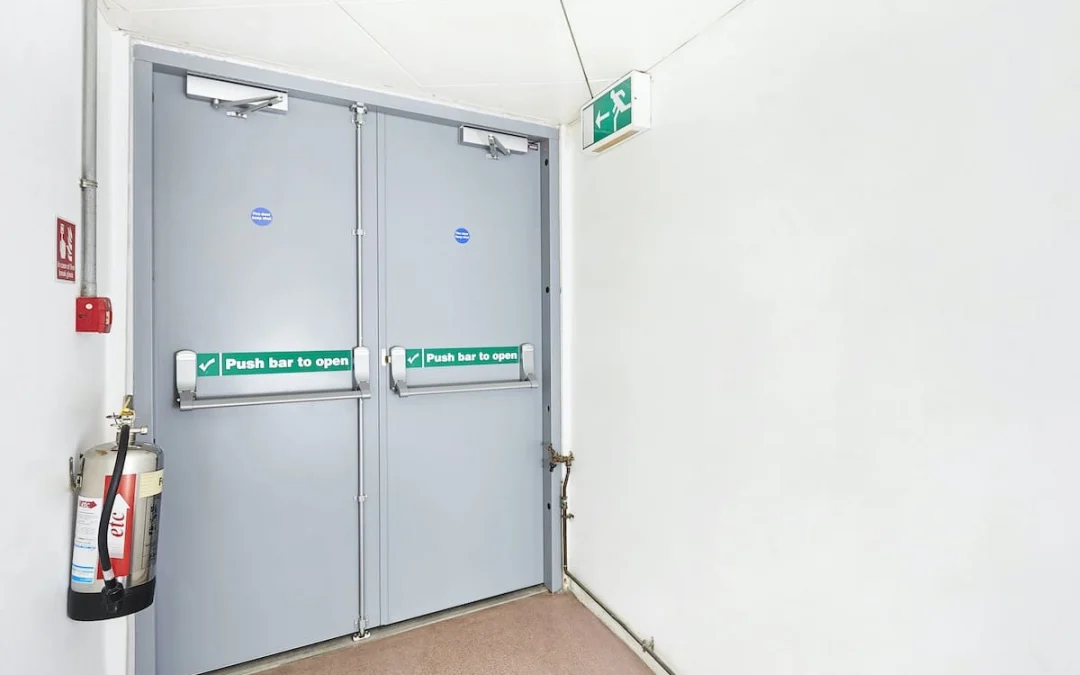Why is a fire door needed?
One of the biggest risks in a fire is the harmful gases and fumes that are emitted, this is where fire doors come into play. If a fire starts a building can become quickly engulfed in smoke making it difficult to breathe and escape. Low-Level Location signage can help guide people to the exits in this situation however fire doors should be the primary tool for creating compartmentation and slowing down the spread of smoke & fire.
What effects can a fire door have?
Fire doors primary use is to create compartmentation which slows down the spread of smoke & fire. For a door to be considered a fire door it must be able to withstand at least 30 minutes of direct flame without letting any smoke or flames get through. In order for this fire, doors are made of fire-resistant materials and are commonly equipped with seals that will melt and seal the gap between the doors and the frame. Fire doors will close automatically and must not be wedged open as this will mitigate its use altogether.
How to identify a fire door that is obsolete?
Once a fire door has been installed it is vital to ensure that it is well maintained and not tampered with, this means there should be no 3rd party modifications from someone who is unqualified to do so. To ensure your fire doors meet regulations takes these into consideration:
- Correct signage in place and clearly visible,
- Seals around the door & frame should not have any cracks or damage,
- The gap between the door/s and frame should be no less than 3mm and no greater than 7mm,
- The door shouldn’t require much force to open or close and it should be able to close fully by itself,
- Ensure that a BWF fire resistance label is found on the door or an indicator from the manufacture of the fire-resistance rating,
- Lastly if doing any repair work ensure that the equipment used eg hinges are BS certified and if using a piece of metal ensure that it is.

Fire Doors F.A.Q.
DO I NEED FIRE DOORS AT MY HOME?
Fire doors are not necessary for domestic homes however it is highly recommended and good practice to utilise fire doors when possible. However commercial and industrial buildings have a legal obligation to ensure fire doors are in place and in good working order. For domestic buildings that have multiple floors & occupants such as apartment buildings then fire doors would be required, it is the responsibility of the landlord or building manager to oversee the inspection of these doors.
CAN I CONVERT A STANDARD DOOR INTO A FIRE DOOR?
No, you can not convert a standard door into a fire door. Even if a door is made of solid timber it is still not recommended that you convert it into a fire-resistant door, giving It a coat of flame retardant paint won’t make it a fire door. Fire doors are made up of a variety of components that all work together to make them a viable solution at slowing down the spread of fire and smoke. Fire doors are built to a high standard and are rigorously tested and inspected by manufacturers and external bodies therefore tampering with a door is not recommended as you could just be affecting its performance & quality.
CAN I LEAVE A FIRE DOOR OPEN?
Yes and No. You may be penalised and your insurance company may refuse your claim if it is found that a fire door has been wedged open without an automatic closing device installed. If a fire door is wedged open and a fire occurs this renders the door obsolete. If are thinking that you could just close the door in the outcome of a fire, you are wrong. Panic can quickly set in once an alarm goes off and your primary focus would and should be on escaping the building, not making sure all the doors are closed. Automatic self-closers can be used to allow the door to remain open in normal circumstances, however, in the event of a fire and the alarm sounding, these devices will automatically release the door to allow full self-closing.
CAN A FIRE DOOR SAVE ME MONEY?
Yes, fire doors can save you money but more importantly they help save lives. A common misconception with fires is that the flames are the most damaging aspect however this is wrong as smoke is the main killer and causes the most damage. There is a brilliant video done by the Fire Safety Research Institute which shows the effect of having a door closed vs having a door open. In the end, there is a dramatic difference between the smoke damage from the room that had the door open vs closed.
SHOULD I USE AN ACOUSTIC DOOR RETAINER SO I CAN LEAVE MY FIRE DOOR OPEN?
Acoustic door retainers are generally a good idea as they allow you to leave the fire door open without the need to worry about closing it if a fire alarm sounds. However, this is not a be all end all solution as these door stoppers can be sensitive and may not work in some situations. For example, In large open rooms with lots of reverb, the acoustic sensor would be able to pick up the sound of an alarm. However, for smaller more confined spaces this can cause issues as sound may be affected by things like curtains or furniture. This could result in a delay or the door retainers not allowing the door to close at all, making it obsolete.
WHAT RATING OF FIRE DOOR DO I NEED?
The majority of fire doors come in FD30 rating, this means the door is able to withstand 30 minutes of fire without degrading and letting heat and smoke through. The resistance strength required depends on the size of the building and the number of occupants. In most scenarios an FD30 will surface however it would still be beneficial to use a higher resistance door as this just gives more time for people to escape safely. There are higher rating doors that go all the way up to FD120 (120 minutes of fire resistance) however these are more expensive and would only be required in larger buildings or where there may be a lot of people who have mobility difficulties for example hospitals or nursing homes.
Open Hours
M-F: 8am – 5pm,
kevinmcteague@mclfire.com


Recent Comments